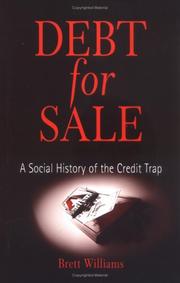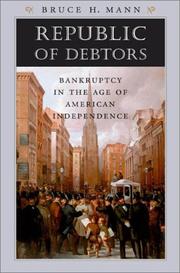| Listing 1 - 10 of 52 | << page >> |
Sort by
|
Book
ISBN: 0585131457 Year: 1999 Publisher: [Place of publication not identified] Nolo
Abstract | Keywords | Export | Availability | Bookmark
 Loading...
Loading...Choose an application
- Reference Manager
- EndNote
- RefWorks (Direct export to RefWorks)
Consumer credit --- Finance, Personal --- Credit ratings --- Consumer debt --- Credit
Book
ISBN: 282183702X 211129375X Year: 2014 Publisher: Paris : Institut de la gestion publique et du développement économique,
Abstract | Keywords | Export | Availability | Bookmark
 Loading...
Loading...Choose an application
- Reference Manager
- EndNote
- RefWorks (Direct export to RefWorks)
Au lendemain de la Seconde Guerre mondiale, le crédit à la consommation a mauvaise réputation. Accordé à des taux souvent élevés, il apparaît surtout contraire à la politique du crédit désormais nationalisé. Les priorités vont au financement de la production et non à la satisfaction des besoins des ménages. Toutefois, en 1953, la Reconstruction s’achève. L’objectif de l’industrie française n’est plus seulement de produire mais de vendre. Or, le pouvoir d’achat des Français reste faible. Soucieux d’accroître leurs débouchés, les industriels se mobilisent pour créer des organismes de crédit en partenariat avec de grandes banques. Le ministère des Affaires économiques les suit pour faire de ce crédit un moyen de relancer la croissance. Encore s’agit-il d’en assainir la distribution. Car, face aux besoins et à l’absence de réglementation, le « crédit noir », usuraire, prospère. C’est précisément à la construction du marché du crédit à la consommation dans les années 1950 et 1960 que ce livre est consacré. Pourquoi la constitution de grands établissements financiers a-t-elle été favorisée ? Comment les nouveaux prêteurs, Sofinco créé en 1951 et Cetelem en 1953, ont-ils évalué les risques du crédit aux particuliers ? La réglementation a-t-elle permis de lutter contre l’usure ? En revenant sur les origines du crédit à la consommation en France, cet ouvrage permet de mieux comprendre les enjeux de l’accès au crédit qui, à l’époque, soulevaient déjà des questions d’une étonnante actualité
Consumer credit --- Government policy --- Consumer debt --- Credit --- economic and financial history

ISBN: 0812218868 9786613211255 1283211254 0812200780 Year: 2011 Publisher: Philadelphia : University of Pennsylvania Press,
Abstract | Keywords | Export | Availability | Bookmark
 Loading...
Loading...Choose an application
- Reference Manager
- EndNote
- RefWorks (Direct export to RefWorks)
Credit and debt appear to be natural, permanent facets of Americans' lives, but a debt-based economy and debt-financed lifestyles are actually recent inventions. In 1951 Diners Club issued a plastic card that enabled patrons to pay for their meals at select New York City restaurants at the end of each month. Soon other "charge cards" (as they were then known) offered the convenience for travelers throughout the United States to pay for hotels, food, and entertainment on credit. In the 1970's the advent of computers and the deregulation of banking created an explosion in credit card use-and consumer debt. With gigantic national banks and computer systems that allowed variable interest rates, consumer screening, mass mailings, and methods to discipline slow payers with penalties and fees, middle-class Americans experienced a sea change in their lives. Given the enormous profits from issuing credit, banks and chain stores used aggressive marketing to reach Americans experiencing such crises as divorce or unemployment, to help them make ends meet or to persuade them that they could live beyond their means. After banks exhausted the profits from this group of people, they moved into the market for college credit cards and student loans and then into predatory lending (through check-cashing stores and pawnshops) to the poor. In 2003, Americans owed nearly
Consumer credit --- Debt --- Consumer debt --- Credit --- Anthropology. --- Business. --- Economics. --- Folklore. --- Linguistics. --- Political Science. --- Public Policy.

ISBN: 0674009029 0674032411 0674040546 9780674040540 0674265785 Year: 2022 Publisher: Cambridge, MA
Abstract | Keywords | Export | Availability | Bookmark
 Loading...
Loading...Choose an application
- Reference Manager
- EndNote
- RefWorks (Direct export to RefWorks)
Debt was an inescapable fact of life in early America. By 1800, imprisonment for debt was under attack and insolvency was no longer seen as a moral failure, merely an economic setback. In this text, the author illuminates this transformation in early American society.
Debt --- Consumer credit --- Bankruptcy --- Dettes --- Crédit à la consommation --- Faillite --- Crédit à la consommation --- E-books --- Consumer debt --- Credit

ISBN: 0262026015 9780262026017 0262524953 9786612097409 1282097407 026226837X 1429477210 9780262268370 9781429477215 Year: 2006 Publisher: Cambridge (Mass.) : MIT Press,
Abstract | Keywords | Export | Availability | Bookmark
 Loading...
Loading...Choose an application
- Reference Manager
- EndNote
- RefWorks (Direct export to RefWorks)
Academic research and policy discussions of credit markets usually focus on borrowing by firms and producers rather than by households, which are typically analyzed in terms of their savings and portfolio choices. The Economics of Consumer Credit brings together leading international researchers to focus specifically on consumer debt, presenting current empirical and theoretical research crucial to ongoing policy debates on such topics as privacy rules, the regulation of contractual responsibilities, financial stability, and overindebtedness.The rapidly developing consumer credit industry in the United States is mirrored by that in Europe, and this volume is noteworthy for its cross-national perspective. Several chapters compare the use of credit markets by households in different countries, while others focus on single country case studies--including consumer credit dynamics in Italy, the role of housing expenditure in the cyclical pattern of borrowing in the United Kingdom, and the use of credit cards by U.S. consumers--to illustrate general insights. Other chapters draw policy lessons from the U.S. experience with bankruptcy regulation and the development of the credit counseling industry. Finally, the book reviews historical, theoretical, and empirical aspects of information sharing, of particular interest in light of the integration of European Union credit markets.ContributorsCarol C. Bertaut, Giuseppe Bertola, Sarah Bridges, Luca Casolaro, Jonathan Crook, Richard Disney, Leonardo Gambacorta, Charles Grant, Luigi Guiso, Michael Haliassos, Andrew Henley, Robert M. Hunt, Tullio Jappelli, Nicola Jentzsch, Marco Pagano, Amparo San Jose Riestra, Michael Staten, Michelle J. White
Consumer credit --- Consumer credit. --- Finance --- Business & Economics --- Credit, Debt & Loans --- 332.743 --- Consumer debt --- Credit --- ECONOMICS/Microeconomics --- ECONOMICS/Finance
Book
ISBN: 3631512376 Year: 2003 Publisher: Frankfurt am Main Lang
Abstract | Keywords | Export | Availability | Bookmark
 Loading...
Loading...Choose an application
- Reference Manager
- EndNote
- RefWorks (Direct export to RefWorks)
351.82*7 --- Consumentenrecht --- Consumer credit --- Consumer protection --- Law and legislation --- 351.82*7 Consumentenrecht --- Consumer debt --- Credit
Book
ISBN: 9782711022700 2711022706 Year: 2015 Publisher: Paris : LexisNexis,
Abstract | Keywords | Export | Availability | Bookmark
 Loading...
Loading...Choose an application
- Reference Manager
- EndNote
- RefWorks (Direct export to RefWorks)
Crédit --- Contrats --- Prêts bancaires --- Crédit à la consommation --- Etablissements de crédit --- Prêts commerciaux --- Droit --- Banking law --- Commercial law --- Consumer credit --- Consumer debt --- Credit --- Établissements de crédit --- Prêts commerciaux.
Book
ISBN: 0716101092 Year: 1972 Publisher: Epping
Abstract | Keywords | Export | Availability | Bookmark
 Loading...
Loading...Choose an application
- Reference Manager
- EndNote
- RefWorks (Direct export to RefWorks)
Book
ISBN: 1108582109 110861535X 1108426735 1108567371 Year: 2019 Publisher: Cambridge : Cambridge University Press,
Abstract | Keywords | Export | Availability | Bookmark
 Loading...
Loading...Choose an application
- Reference Manager
- EndNote
- RefWorks (Direct export to RefWorks)
Personal debt remains an important factor in many economic models because it encourages people to use debt to finance consumption. Whether this model is sustainable for individuals or the countries in which they reside is an ongoing question of great complexity and many social and economic implications, not only for the burdened individuals and their countries, but also for the EU as a whole. In Personal Debt in Europe, Federico Ferretti and Daniela Vandone examine the 'dark side' of personal debt, or over-indebtedness, in social and economic terms. They employ cross-country consumer-level data to present the latest empirical studies on the problem, analyse these findings to better understand its nature and causes, and discuss the merits of proposed insolvency legislation and harmonisation initiatives in the EU.
Consumer credit --- Loans, Personal --- Debt --- Consumer debt --- Credit --- Indebtedness --- Finance --- Consumer loans --- Loans, Consumer --- Loans, Small --- Personal loans --- Small loans --- Loans --- Law and legislation
Book
ISBN: 113989840X 1139904345 1139059041 1107015650 110769390X Year: 2014 Publisher: Cambridge : Cambridge University Press,
Abstract | Keywords | Export | Availability | Bookmark
 Loading...
Loading...Choose an application
- Reference Manager
- EndNote
- RefWorks (Direct export to RefWorks)
Why did America embrace consumer credit over the course of the twentieth century, when most other countries did not? How did American policy makers by the late twentieth century come to believe that more credit would make even poor families better off? This book traces the historical emergence of modern consumer lending in America and France. If Americans were profligate in their borrowing, the French were correspondingly frugal. Comparison of the two countries reveals that America's love affair with credit was not primarily the consequence of its culture of consumption, as many writers have observed, nor directly a consequences of its less generous welfare state. It emerged instead from evolving coalitions between fledgling consumer lenders seeking to make their business socially acceptable and a range of non-governmental groups working to promote public welfare, labor, and minority rights. In France, where a similar coalition did not emerge, consumer credit continued to be perceived as economically regressive and socially risky.
Consumer credit --- Bank loans --- Public welfare --- POLITICAL SCIENCE / Economic Conditions. --- Finance --- Business & Economics --- Credit, Debt & Loans --- Bank credit --- Loans --- Consumer debt --- Credit
| Listing 1 - 10 of 52 | << page >> |
Sort by
|

 Search
Search Feedback
Feedback About UniCat
About UniCat  Help
Help News
News